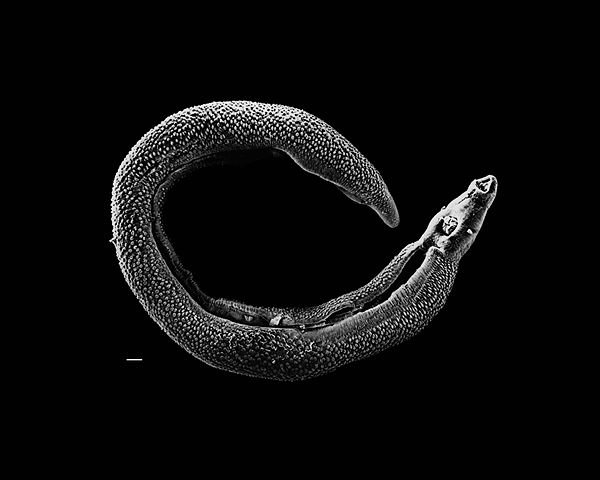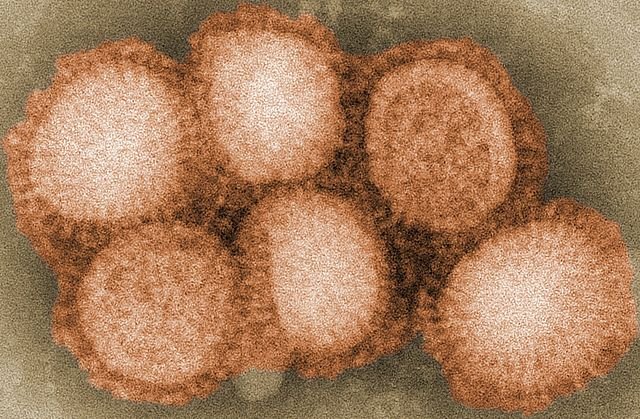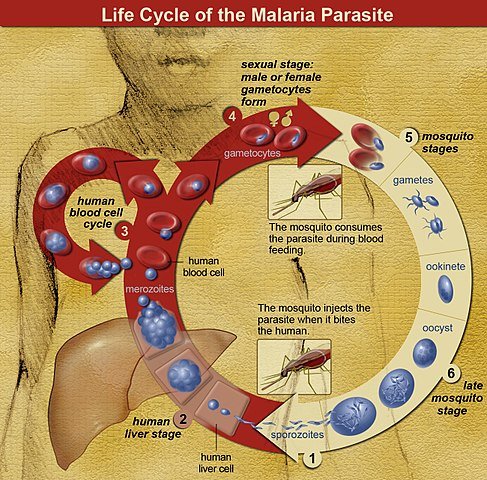HEALTH AND DISEASES: Parasitic and Lifestyle Diseases.
Hello, dear readers. This post is a follow-up to my write-ups of couple of months ago titled HEALTH AND DISEASES: Introducing disease and how disease-causing factors influence each other and the part 2. In this present post, I want to explain more on parasitic and lifestyle diseases and their various types.
PARASITIC DISEASES
Bacteria and viruses are microorganisms; they are too small to be seen with the naked eye. However, some larger organisms also cause disease. These are the protoctists and the parasitic worms. In Europe, they are relatively rare, but on a global scale they have an enormous impact. Over half the world's population is infected by at least one of the four parasitic worms such as the roundworm, tape worm, hookworm and the blood fluke.

It is all too easy to concentrate on the horrors of parasitic infections. As biologists we should not forget that parasites as a group provide one of the best examples of adaptation. A useful definition of a parasite is as follows:
A parasite is an organism that lives in or on a host organism. It gains a nutritional advantage from this relationship while the host suffers a disadvantage.
It might seem that this is a very easy way of making a living, but think about the conditions a parasitic worm faces, living in your intestine. There are obvious advantages in lying in a soup of pre-digested food. There is no need to produce digestive enzymes, a complex nervous system is unnecessary because food does not need to be searched for, and a locomotory system is almost a disadvantage since the worm might move to less favourable areas of the gut.
On the other hand, there are disadvantages. Parasites are made of the same complex macromolecules as the food that you eat, so they must avoid being digested and must try to stay put despite the constant contractions of the gut muscles. It's also difficult to move from the intestine of one person into the intestine of another. Because of this, life cycles can be very complex and many involve intermediate hosts. Since the chances of completing the life cycle and reaching a new host are small, many parasites produce vast numbers of offspring.
Bird flu: should we be worried?
Flu pandemics occur every few years and experts seem to agree that, as at 2010, a new pandemic is overdue. In 2004, a new variant of the flu virus appeared and started to infect people and kill them. Only a few people were infected at first, but many of them died. The virus that caused the flu was extremely virulent. The virus was studied and named H5N1 - it seems to be a virus that has developed in wild populations of birds, possibly in Asia. It is now commonly known as 'bird flu' or 'avian flu'.
Experts are extremely worried about the H5N1 virus. So far, there has been only few proven case of the virus passing from person to person. All the other cases of infection have occurred when the virus has passed from bird to human - these cases are also relatively rare because they occur mostly in rural farming communities where people still live with their livestock. Although the virus spread throughout the world in birds, the flu pandemic seriously affected people.

What might happen though is that the virus, in one of its transfers between birds and humans, will mutate so that it becomes able to pass from person to person. If it then becomes able to do this easily, a world pandemic could occur, killing millions of people. This would be a situation similar to that in 1918, when about 60 million people died.
The H5N1 virus has properties that are very similar to the flu virus of the 1918 pandemic…
MALARIA
Malaria is caused by four species of the protoctist Plasmodium – P. vivax, P. falciparum, P. ovale and P. malariae. They are transmitted by the bite of the Anopheles mosquito.
During the 1960s, malaria was successfully eradicated from the warmer areas of southern Europe and the USA, and its incidence was reduced significantly in many countries in the tropics. But the disease is now on the increase again. In 2018, the WHO estimates that there are 228 million cases of malaria infections worldwide, along with 110 million cases of illness and 405 000 deaths. Malaria is endemic in at least 31 countries of the tropical and subtropical regions of the world; there are an astounding millions of people at risk of malaria infection, and malaria is the cause of a quarter of all childhood deaths in Africa.
There are several reasons why the disease is so widespread: the cost or maintaining control programmes is high, insecticide resistance has become more common in the mosquito that transmits malaria, and the malarial parasite itself has developed drug resistance.
Signs and symptoms of malaria
One of the most characteristic features of malaria is the pattern of fever, with temperature peaks at regular intervals. These correspond to a new generation of parasites bursting out of the red blood cells, destroying them and causing anaemia. The parasites can block capillaries, limiting the blood supply to organs in the body: the brain, digestive system and kidneys can all be affected.

Control and treatment of malaria
One way to combat malaria is to break the cycle of infection. This can be done by killing the mosquitoes with insecticides, clearing the pools of stagnant water in which the larvae live and preventing the insects from biting humans.
Where possible, the risk can be reduced by sleeping under mosquito nets, wearing long-sleeved shirts and trousers after dark when mosquitoes are most active, and using mosquito repellents. But all these measures are expensive for many local people. Also, they are not certain to work.
Anti-malaria drugs
The anti-fever properties of the bitter bark of the tree Cinchona ledgeriana were known in Peru before the fifteenth century. Quinine, the active ingredient in the bark, was first isolated in 1820. Chloroquine is now the most commonly used anti-malaria drug in Africa. It lowers fever and reduces the number of parasites in the body. Resistance to chloroquine, however is widespread and has been rising steadily since the early 1980s. For this reason, it is used in combination with other drugs. Research continues into resistance-reversing drugs, but so far only a few useful drugs have emerged.
Drugs based on artemisinin are important treatments for severe malaria. These are derived from the Chinese plant Artemesia annua (or quinghaosu). They are effective, fast-acting, but relatively expensive drugs. An infusion of quinghaosu (Artemesia annua) has been used for at least the past 2000 years in China, its active ingredient artemisinin has only recently been scientifically identified. Artemether and quinine are some of the anti-malarial drugs most suitable for the treatment of severe malaria in children.
Will there ever be a vaccine for malaria?
Despite decades of research effort, no one has yet managed to develop a vaccine that is effective against a protoctist such as Plasmodium so patients continue to suffer. Several potential malarial vaccines have been developed, but many have run into problems. There is presently no commercially available malaria vaccine. Although over 20 other vaccine constructs are currently being evaluated in clinical trials or are in advanced preclinical developmentsource. The vaccine developed by Manuel Patarroyo in Colombia has been tested in people and seemed to be the answer everyone was waiting for. However, further trials showed that the vaccine was not protective, and arguments about it have raged ever since.
Recently, molecular biologists are using two main tactics to find a suitable vaccine. Some are trying to identify antigens that appear on the parasite's surface at various stages of its life cycle. The idea is to put several Plasmodium genes into the harmless vaccinia virus, and then introduce it as a recombinant vaccine into the body. Once inside, it divides a few times and sets up a good immune response to Plasmodium. Some of these recombinant vaccines look promising and may be tested in humans very soon.
The other approach is to develop a DNA vaccine for malaria. The aim is to isolate the Plasmodium genes that provoke an immune response during infection, and to put them into a plasmid. This is a ring of DNA obtained from bacteria. The DNA itself is introduced into the body where it uses the human cell machinery to make the proteins coded for in the genes. The person's immune system detects these proteins, and makes an immune response. It is this response that could combat the real infection if the person is later exposed to Plasmodium.
Another approach, announced late in 2001, is to express proteins that can stimulate immunity to Plasmodium parasites in goat's milk. Researchers showed that it was possible to produce transgenic mice that could express proteins from Plasmodium in their milk and experiments were then started to try to produce goats to do the same thing. The advantage of this strategy is that a herd of goats could probably produce enough vaccine for the whole of sub-Saharan Africa.
A much more recent approach is the RTS,S/AS01. It is currently the most advanced vaccine candidate against the most deadly form of human malaria, Plasmodium falciparumsource. Trials of various types of malarial vaccine are in progress and new approaches are being investigated. Even so, it could be at least 5 years before we have a real hope of a use-able vaccine for humans.
LIFESTYLE DISEASES
Non-communicable diseases or lifestyle diseases are the major cause of death in the more developed countries. Cardiovascular disease, which is when the heart and circulatory system become diseased, many types of cancer and some diseases of the respiratory system can all affect people as a result of things they eat, drink or smoke, and the way they live. Factors that affect a person's chance of developing a particular condition are called risk factors.
ATHEROSCLEROSIS AND CARDIOVASCULAR DISEASE
Cardiovascular disease is a major lifestyle disease in most developed countries. An estimated 17.9 million people died from CVD in 2016 according to WHOsource. It claims about 175 000 lives per year in the UK and almost a million lives per year in the USA. As its name suggests it involves the cardiovascular system - the heart and blood vessels that transport blood throughout the body.

Cardiovascular disease is a general term that covers all diseases of the heart and blood vessels. Coronary heart disease is a much more specific term, referring to the build up of atheroma in the coronary arteries and the problem this causes.
Cardiovascular disease is more common in people over 50, but it can happen in younger people. It shows itself in many ways but it has a common underlying physiological cause: the narrowing and clogging up of arteries as a result of atherosclerosis. I will look at this process in detail later in the chapter, but first I will like to explain the different forms of cardiovascular disease, which will be done in my next post.
Thanks for coming.
REFERENCES
https://en.wikipedia.org/wiki/Parasitic_disease
https://www.healthline.com/health/parasitic-infections
https://www.cdc.gov/parasites/az/index.html
https://en.wikipedia.org/wiki/Avian_influenza
https://www.healthline.com/health/avian-influenza
https://www.cdc.gov/flu/avianflu/index.htm
https://www.healthline.com/health/malaria
https://www.who.int/news-room/fact-sheets/detail/malaria
https://www.cdc.gov/malaria/about/faqs.html
https://www.the-scientist.com/news/one-colombians-quest-for-a-malaria-vaccine-62354
https://en.wikipedia.org/wiki/Manuel_Elkin_Patarroyo
https://www.ncbi.nlm.nih.gov/books/NBK215631/
https://en.wikipedia.org/wiki/Antimalarial_medication
https://en.wikipedia.org/wiki/Malaria_vaccine
https://www.who.int/immunization/research/development/malaria/en/
https://en.wikipedia.org/wiki/Lifestyle_disease
https://medcraveonline.com/JCCR/lifestyle-diseases-consequences-characteristics-causes-and-control.html
https://www.medicinenet.com/script/main/art.asp?articlekey=38316
https://en.wikipedia.org/wiki/Atherosclerosis
https://www.mayoclinic.org/diseases-conditions/arteriosclerosis-atherosclerosis/symptoms-causes/syc-20350569
https://www.who.int/health-topics/cardiovascular-diseases/
https://www.who.int/news-room/fact-sheets/detail/cardiovascular-diseases-(cvds)
https://www.nhs.uk/conditions/cardiovascular-disease/
https://www.who.int/news-room/fact-sheets/detail/cardiovascular-diseases-(cvds)
That's a really interesting post. Thank you for sharing!
!discovery 40
Thank you for coming by, @delilhavores. I'm glad you found the post interesting.
Questo post è stato condiviso e votato all'interno del discord del team curatori di discovery-it Entra nella nostra community! hive-193212
This post was shared and voted inside the discord by the curators team of discovery-it. Join our community! hive-193212
Thanks for your contribution to the STEMsocial community. Feel free to join us on discord to get to know the rest of us!
Please consider supporting our funding proposal, approving our witness (@stem.witness) or delegating to the @steemstem account (for some ROI).
Please consider using the STEMsocial app app and including @stemsocial as a beneficiary to get a stronger support.